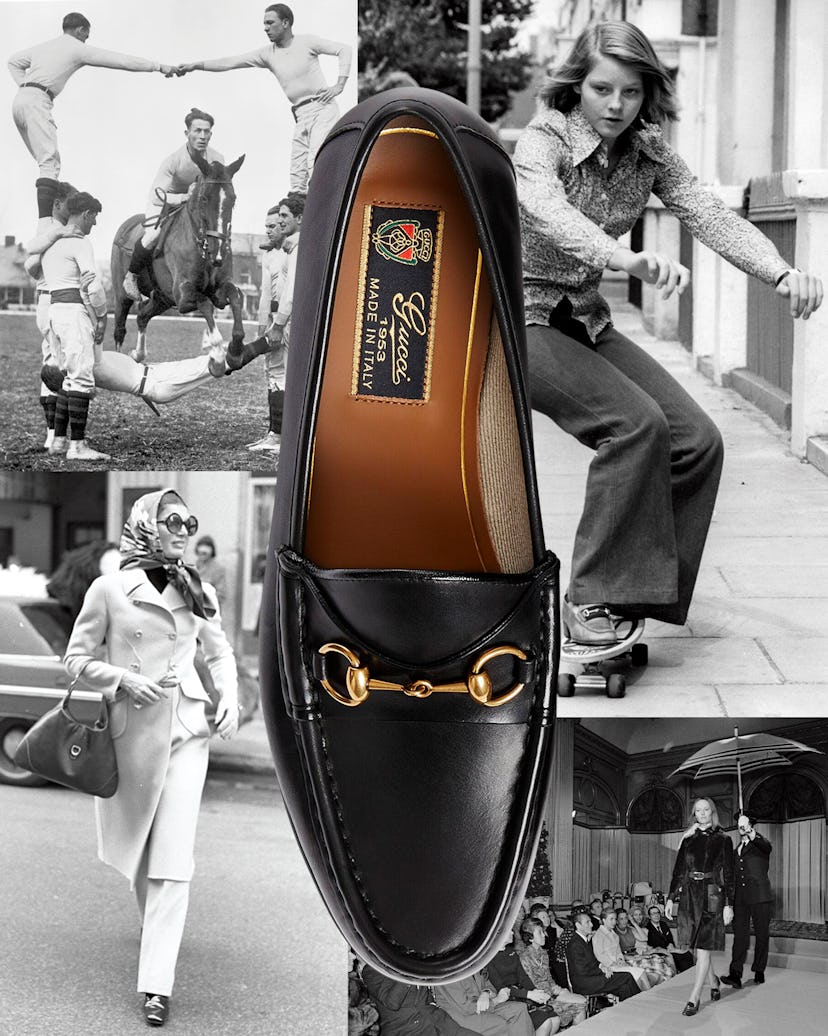How the Gucci Horsebit Loafer Became the Original It Shoe
The relaxed but elegant staple is turning heads once again.

Like gelato and talking with one’s hands, the Gucci Horsebit loafer is one of Italy’s most adored cultural exports. An early exemplar of la dolce vita lifestyle, nonchalant luxury, and brand virality, it was released in 1953, at a time of rapid expansion for Gucci—just as the house was opening its Manhattan flagship, at the Savoy-Plaza Hotel, on East 58th Street. According to company lore, Aldo Gucci (who, along with his brothers Rodolfo and Vasco, took over the business from their father, Guccio, the founder) brought out the dressy loafers in response to the rise of comfortable knockabout moccasins such as the Bass Weejuns, which he noticed were popular with American prepsters.
The elevated Gucci offering, in black lightweight leather and featuring an almond-shaped toe and a distinctive gilded snaffle that alluded to the company’s equestrian roots, was an instant hit—particularly in Italy. Originally for men, the shoe was soon followed by women’s versions, and both won the hearts—and lire—of newly solvent Italians enamored with the design objects that they associated with their country’s postwar rebirth.
As jet-setting paparazzi bait like Sophia Loren, Jane Birkin, Jacqueline Kennedy, and Lee Radziwill beat a path to the Gucci store on Rome’s Via Condotti, the Horsebit became an early It shoe, and it didn’t take long for its popularity to spread Stateside. As ubiquitous as Gucci is now, thanks to its global retail footprint and enviable digital reach, it’s hard to imagine how unheard of it was in those days for a design to hijack the international spotlight, and to appeal to both women and men.
A young Jodie Foster rides a skateboard while wearing the shoe, 1977.
The loafer takes its cues from equestrian culture.
The Horsebit’s impact went beyond sales figures. It was in step with a changing, more liberal approach to conventional dress codes. Understated yet easily recognizable from a distance, it exuded carefree glamour, with just a hint of status signaling. Before the advent of the sneaker, it was one of the few casual shoes acceptable in corporate boardrooms and country clubs alike. By the 1970s, it was being photographed on a teenage Jodie Foster while she skateboarded, and on then CIA director George H. W. Bush as he visited the White House.
Today the loafer remains closely associated with Italian craftsmanship and cultural heritage and is a staple of Gucci collections. It was recently the subject of “Gucci Horsebeat Society,” an exhibition held during the men’s shows in Milan celebrating all its iterations over the years, including a red pump from the watershed Gucci fall/winter 1995 collection, designed by Tom Ford. The snaffle still evokes the offhand refinement that comes from a life well lived, and it now appears on a stable of accessories in assorted colors and styles, including furry mules.
As the fashion world waits with bated breath to see how Gucci will continue to evolve under the direction of new creative director Sabato De Sarno. No doubt he will have a different take on contemporary dressing than his predecessors—but it’s a safe bet that the horsey classic will continue riding high. Its selling point may be comfort and ease, but its history is anything but idle.
The loafer making strides down the Gucci runway in Paris, 1972.
Jacqueline Kennedy Onassis in New York, carrying the Gucci “Jackie” handbag and wearing Gucci shoes, 1970.
For his first collection as creative director at Gucci, Sabato De Sarno unveiled a flatform version of the famous loafer.
This article was originally published on